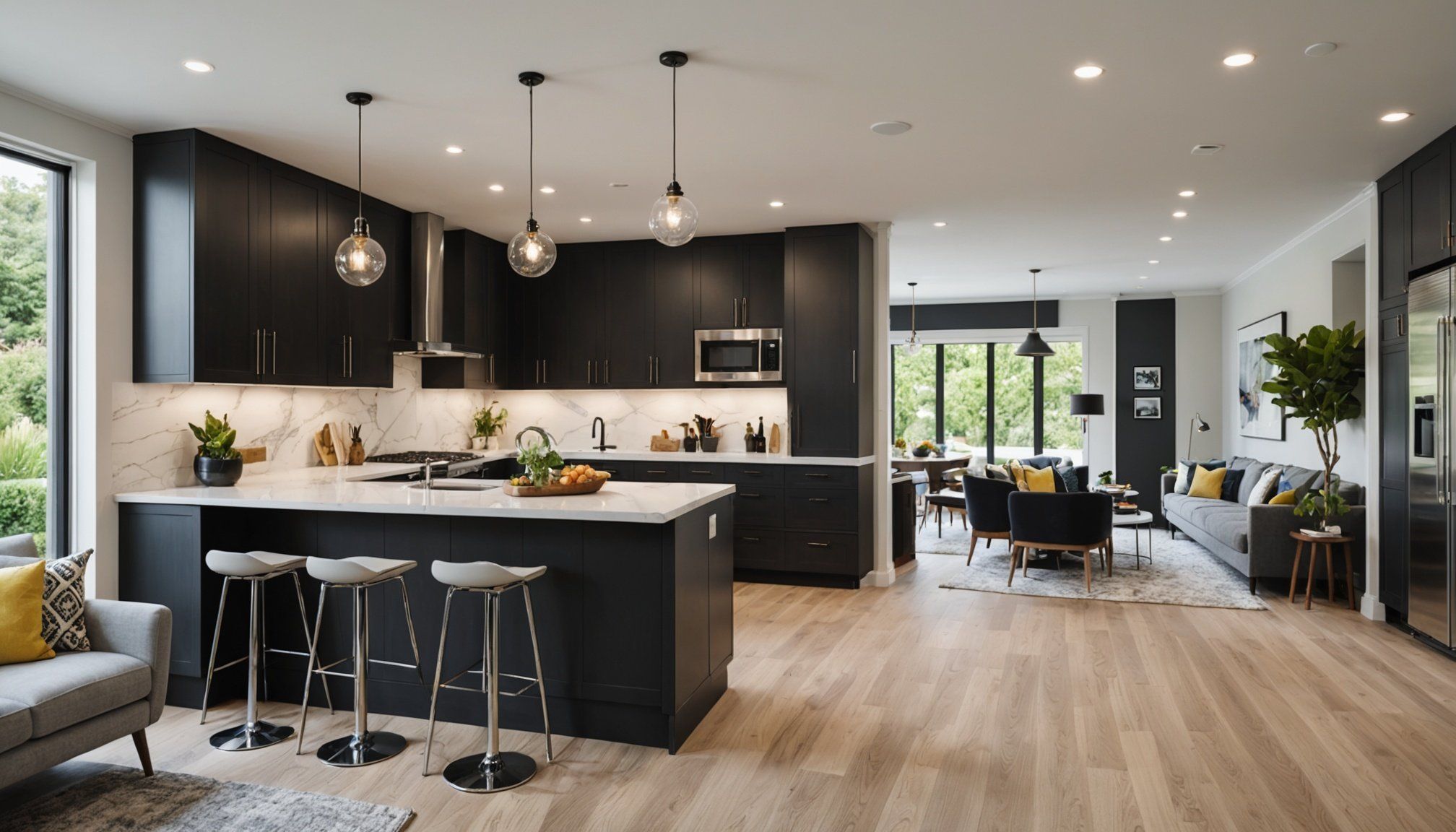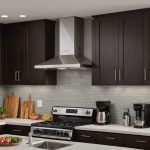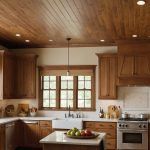Design Principles for Seamless Spaces
Creating a cohesive design in your home can significantly enhance its functionality and aesthetic appeal. One fundamental aspect is the use of open floor plans, encouraging flow between areas. These layouts eliminate barriers, promoting a continuous flow between areas, making spaces feel more expansive and interconnected.
To achieve a truly integrated space, it’s crucial to utilize consistent design elements. This involves harmonizing color schemes, textures, and materials across different rooms. Maintaining continuity in design ensures unity and reinforces the seamless transition from one area to another. Selecting furnishings and decor that resonate with the overall theme plays a pivotal role in providing a unified appearance.
Also to see : Revamp your kitchen: innovative ideas to add a chic pet feeding station
Balancing functionality with aesthetic appeal is essential in cohesive design. Practical considerations, such as traffic flow and accessibility, should not be overlooked. However, these elements should complement, not compete with, the visual aspects. A well-balanced space doesn’t sacrifice beauty for practicality; instead, it merges both to create an inviting and efficient environment.
In essence, mastering these principles can transform the dynamic of your dwelling, providing a harmonious blend of function and cohesive design. A thoughtful approach ensures that each segment of the space contributes to an overall sense of unity and flow.
In the same genre : Revamp your kitchen: innovative ideas to add a chic pet feeding station
Color Schemes for Cohesive Interiors
Achieving design unity in interconnected spaces like living rooms and kitchens can elevate harmony and functionality. By selecting a well-thought-out color palette, you unify these areas seamlessly. Harmonious colors should be chosen to complement each other naturally. A consistent scheme prevents visual disruption and enhances the perception of spaciousness.
Psychological Impact of Colors
Understanding the psychological effects of colors helps create atmospheres that resonate. For instance, warm hues like reds and yellows can energize, making them suitable for active spaces like kitchens. Conversely, cooler tones such as blues or greens often invoke calm, ideal for living areas where relaxation is key.
Tips for Accent Colors
To incorporate accent colors without disturbing environment flow, consider these tips:
- Use accent colors sparingly and in specific elements, like cushions or artwork.
- Anchor bold accents with neutral shades to maintain balance.
- Repeat accent colors in both spaces to ensure cohesion.
By strategically integrating accent colors, you can add character while preserving a unified aesthetic. Adopting a cohesive color strategy not only enhances visual appeal but also supports the functional ambiance of a home.
Functional Layout Ideas
Arranging furniture strategically is key to achieving a functional layout that maximizes space and enhances movement within a room. By assessing your space thoroughly, you can determine the best furniture arrangement to allow seamless navigation. For instance, placing larger furniture against walls can open up central areas for easy movement.
Multi-functional Furniture Pieces
Incorporating multi-functional furniture is crucial in optimizing space. Pieces such as sofa beds or coffee tables with storage provide dual purposes, thus saving space and adding utility. From transforming desks to folding dining tables, these versatile items adapt to various needs, making them indispensable in modern homes.
Zoning Techniques
Zoning is an effective technique used to define living and kitchen areas without the need for physical barriers. This can be achieved by using rugs, different flooring materials, or arranging furniture in unique groups. By allocating specific functions to distinct areas, you establish a clear flow and optimize space efficiently. A well-thought-out layout design not only adds aesthetic appeal but also serves practical purposes, enhancing the overall home experience.
Selecting the Right Furnishings
Choosing the right furniture choices is crucial in achieving a harmonious and cohesive style for any living space. When selecting furniture that complements both spaces, consider balancing comfort and aesthetics. Begin by evaluating the existing decor and use consistent colours and themes across rooms to form a connection. This doesn’t mean everything must match. Rather, seek items that share a similar style or vibe.
Texture and materials play a pivotal role in maintaining design cohesion. Incorporate a mix of materials such as wood, metal, or glass to add depth while ensuring these materials complement each other across different areas. For example, if one room features a sleek metal finish, echo it in another with a decorative metal vase or lamp.
When selecting statement pieces, aim for those that underpin the overall design vision. These stand-out items should reflect your personal taste and help unify the spaces. It could be an elegant sofa, an eye-catching coffee table, or an artistic piece of wall decor. The key is to choose pieces that resonate across rooms, visually linking them to enhance the flow and continuity of your home.
Accessorizing for Harmony
Accessorizing plays a vital role in establishing a unified style across both kitchen and living areas. Seamless integration of decor accessories like artwork, vases, or cushions can create visual continuity. Start by selecting a consistent theme that resonates with both spaces. This might be a colour palette, material, or motif.
Consider how lighting can enhance the harmony between these areas. Using similar fixtures or matching finishes in connected spaces can amplify visual coherence. For example, pendant lights over the kitchen island can echo the living room’s ceiling lights.
Tips for Blending Decorative Elements
To achieve a cohesive look, use accessories that share common elements. Here are some ideas:
- Mirrors can reflect light and tie designs together.
- Rugs with similar hues or patterns can connect different floors.
- Plants add a natural element that suits many styles.
Such techniques help maintain an overall aesthetic, making transitions between spaces less jarring. Remember, less is sometimes more when aiming for a unified style. Focus on balance and simplicity to ensure your home feels intentionally designed.
Common Challenges and Solutions
Designing a space can be daunting, with design challenges often presenting themselves as significant hurdles. Recognizing common pitfalls, such as mismatched elements and improper flow, is crucial for creating a cohesive design. One major issue can be failing to maintain balance between areas, leading to a space that feels disjointed.
Functional problems often arise due to space constraints and awkward layouts. For example, a small room may feel cramped, or an oddly-shaped area might seem impossible to style effectively. Expert solutions can transform these challenges into opportunities. For tight spaces, incorporating multi-functional furniture is key. This allows the room to serve multiple purposes without sacrificing style or utility.
Professional tips can be invaluable in achieving balance and harmony. Begin by considering the visual weight of different elements. For instance, a large, bold piece should be counterbalanced by other substantial items in the room. Similarly, maintain consistency in materials and color palettes to tie different areas together seamlessly.
Addressing these design and functional problems with expert solutions can ensure a cohesive and welcoming environment. Consistently implementing these strategies will transform a challenging space into a harmonious one.
Understanding Seamless Spaces
Seamless spaces in modern homes refer to design concepts where boundaries between rooms are minimized, often seen in open concept living. This ethos aims to create a unified layout, promoting free movement and connectivity throughout the home. Such designs not only enhance aesthetic appeal but also improve functionality by making spaces more versatile.
One popular application is blending the kitchen and living areas, creating a communal zone for cooking, dining, and lounging. This open concept living is favored for its practicality—it allows for easier interaction during meal preparation and social gatherings, facilitating a more integrated lifestyle.
Several design styles support seamless integration. Minimalist designs, for example, emphasize simplicity and cohesive color palettes to promote flow. Scandinavian interiors use neutral tones and natural materials, providing an airy and bright environment. Then there’s the modern industrial style, showcasing raw textures and open spaces that naturally suggest unity.
Overall, adopting seamless design principles in a home underscores both practical and visual benefits. They enable flexible use of space, cater to social dynamics, and embody a contemporary lifestyle, meeting the demands of modern living.
Practical Design Tips for Cohesion
Creating a cohesive design in a home involves thoughtful integration tips to ensure a seamless flow between spaces. A crucial aspect is selecting complementary color schemes for key areas such as the kitchen and living room. Matching or analogous hues can promote visual harmony, making transitions between these areas more natural.
Equally important is utilizing consistent materials and finishes throughout the home. This might involve selecting a similar wood grain for both your floors and cabinetry or using a unified metal finish for fixtures and hardware. Such consistency ensures that each space feels like a part of a larger whole, rather than isolated segments.
Lighting design also plays a pivotal role in creating a unified atmosphere. Layering ambient, task, and accent lighting helps highlight design features while maintaining cohesion between different areas. For instance, pendant lights over a kitchen island can echo the chandeliers in the living area in both style and material.
Integrating these elements requires a balance between continuity and individuality, ultimately crafting a space that feels united yet unique. A holistic approach to these transitional spaces helps in achieving a well-integrated home environment.
Layout Suggestions for Optimal Flow
Designing an open floor plan requires thoughtful space optimization and the creation of a functional layout that enhances flow and connectivity.
Arranging Furniture for Connectivity
To enhance interaction and connectivity, consider arranging furniture in a manner that promotes easy conversation and accessibility. Position seating to face each other or a common focal point, such as a fireplace or TV stand. This not only invites dialogue but also seamlessly bridges spaces, like the kitchen to the living room.
Zones and Transitions
In an open space, define distinct areas without physical barriers. Subtle zoning can be achieved with area rugs or strategic furniture placement. For example, set a dining table slightly away from couches to delineate the dining area from the living room. Maintaining a balance is key to keeping open spaces functional without compromising on spaciousness.
Smart Storage Solutions
Integrating smart storage solutions is crucial to minimize clutter. Consider built-in storage like cupboards or shelves that serve both aesthetic and practical purposes. Use shelving creatively to connect different environments, providing continuity while storing essentials. Additionally, multi-functional furniture, such as ottomans with hidden storage, optimizes space utility.
Color Palettes and Materials
Creating a harmonious design involves understanding the nuances of color harmony and material selection. By exploring current color trends, one can enhance a seamless design that captures the eye. For example, muted earth tones and soft pastels are currently popular, bringing a sense of tranquility that complements various styles. These colors not only add depth but also reinforce a room’s atmosphere.
Equally important is the thoughtful combination of textures and materials. Mixing wood with metal, or glass with stone, adds an engaging layer of complexity and elegance. Texture integration ensures each piece contributes to a cohesive look, preventing any element from feeling out of place. By merging different materials, designers can create spaces that feel both dynamic and unified.
Lastly, the impact of finish types should not be overlooked. Glossy surfaces exude modern sophistication, while matte finishes offer a more subdued, classic appearance. Choosing the right finish is critical in achieving the intended design aesthetics, as it can either elevate or undermine the overall impact. The key lies in balancing these finishes to maintain style consistency and amplify the space’s inherent beauty.
Overcoming Design Challenges
Tackling design obstacles in home projects can be daunting. A frequent issue is achieving seamless integration without disrupting the existing aesthetic or functionality. Ensuring that new elements harmonise with current settings often presents significant challenges.
Common Design Obstacles
Common hurdles include discrepancies in style or functionality. These design obstacles may stem from trying to incorporate modern features into older homes or blending different architectural styles. Functional integration can further complicate matters—how do you ensure a new feature enhances, rather than detracts from, usability?
Solutions and Expert Insights
Addressing these challenges requires a balance of creativity and strategy. Begin by:
- Assessing the existing design: understand the core elements.
- Aligning new additions: ensure they complement overall aesthetics.
Consulting professionals can provide a wealth of expert insights. It’s vital to seek their advice when facing complex design obstacles. Architectural experts can offer unique solutions tailored to your home’s specific needs. Contact them during the early planning stages to ensure any changes enhance the property’s value and function.
By deploying strategic tips and leveraging expert advice, overcoming design obstacles becomes a manageable, even rewarding task, leading to a cohesive and functional living space.
Inspiring Examples of Seamless Spaces
Embarking on a journey of designing your space can be made more exciting and navigable through visual examples and design inspiration. These examples serve as a motivational backdrop, encouraging innovative and cohesive interiors that breathe life into any home.
Case studies of successful designs provide a tangible visual example of how elements harmoniously come together to create a seamless environment. These transformations often start with a holistic approach, considering the flow of spaces and the unity between areas. They highlight how textures, colours, and furniture work concertedly to form a unified setting, encouraging you to explore similar ideas in your designs.
Real-life homes further showcase creative solutions to common design challenges. These innovative solutions can spur fresh ideas, helping transform spaces into something unique yet cohesive. Whether it’s a cleverly integrated storage unit or an open-plan layout with subtle room delineations, these examples can inspire you to reconsider how everyday elements are placed and used in your space.
By regularly visiting these cohesive interiors and studying their implementations, you arm yourself with the confidence and ideas needed to make informed and inspired choices in your design journey.
DIY Ideas for a Cohesive Environment
Creating a harmonious living space doesn’t have to break the bank. You can achieve a seamless design by engaging in a range of DIY home projects. These projects not only bring personal touches to your space but also help in demonstrating your style and creativity.
Start by selecting a colour palette that flows naturally throughout various rooms. Paint can be a powerful, budget-friendly solution to unify spaces. Choose complementary shades and use them in different areas to establish continuity.
Incorporating personal elements is another way to achieve cohesiveness. Try displaying a collection of framed family photos or favourite artworks in a common area like a hallway or living room, linking spaces visually. Additionally, consider upcycling furniture; revamp old pieces with a fresh coat of paint or new fabric to give them new life while maintaining character.
Finally, keep costs down with smart shopping. Search for deals at thrift stores or flea markets. Many DIY enthusiasts find unique items at affordable prices that add charm and completeness without overspending. Being creative with your budget can lead to a cohesive environment full of personality and warmth.
Current Trends in Seamless Space Design
In today’s world of design trends, open living and kitchen areas have taken center stage. This seamless transition between spaces not only reflects modern aesthetics but also promotes a sense of connectivity and fluidity within homes. One of the key innovative solutions driving this movement is the use of advanced materials and finishes that create a unified look throughout these areas.
Technologies such as smart lighting and automated climate control now play pivotal roles in fostering seamless integration. These systems adjust to the time of day, activity, and occupancy, enhancing the modern aesthetics and functionality of open spaces. Moreover, wireless charging stations and concealed wiring ensure that technology remains convenient yet unobtrusive.
As we look towards the future, predictions suggest that modular furniture and adaptable layouts will become standard, catering to varying needs without compromising the cohesive design. Innovations in virtual reality might also allow homeowners to visualize and experiment with different design elements before committing, making the design process more interactive. This blend of technology and style epitomizes the evolution of space design, reflecting both current tastes and future aspirations for more connected, harmonious living environments.











